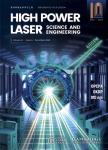Review of the current status of fast ignition research atthe IAPCM
Review of the current status of fast ignition research atthe IAPCM作者机构:Institute of Applied Physics and Computational Mathematics Center for Applied Physics and Technology Peking University
出 版 物:《High Power Laser Science and Engineering》 (高功率激光科学与工程(英文版))
年 卷 期:2014年第2卷第1期
页 面:4-12页
核心收录:
学科分类:08[工学] 082701[工学-核能科学与工程] 0827[工学-核科学与技术]
基 金:supported by the National Natural Science Foundation of China (Grant Nos. 11275028 11105016 and 91230205)
主 题:fast ignition integrated simulation codes
摘 要:We review the present status and future prospects of fast ignition(FI) research of the theoretical group at the IAPCM(Institute of Applied Physics and Computational Mathematics, Beijing) as a part of the inertial confinement fusion project. Since the approval of the FI project at the IAPCM, we have devoted our efforts to improving the integrated codes for FI and designing advanced targets together with the experimental group. Recent FI experiments [K. U. Akli et al., Phys. Rev. E 86, 065402(2012)] showed that the petawatt laser beam energy was not efficiently converted into the compressed core because of the beam divergence of relativistic electron beams. The coupling efficiency can be improved in three ways:(1) using a cone–wire-in-shell advanced target to enhance the transport efficiency,(2) using external magnetic fields to collimate fast electrons, and(3) reducing the prepulse level of the petawatt laser beam. The integrated codes for FI, named ICFI, including a radiation hydrodynamic code, a particle-in-cell(PIC) simulation code,and a hybrid fluid–PIC code, have been developed to design this advanced target at the IAPCM. The Shenguang-II upgraded laser facility has been constructed for FI research; it consists of eight beams(in total 24 kJ/3ω, 3 ns) for implosion compression, and a heating laser beam(0.5–1 kJ, 3–5 ps) for generating the relativistic electron beam. A fully integrated FI experiment is scheduled for the 2014 project.



